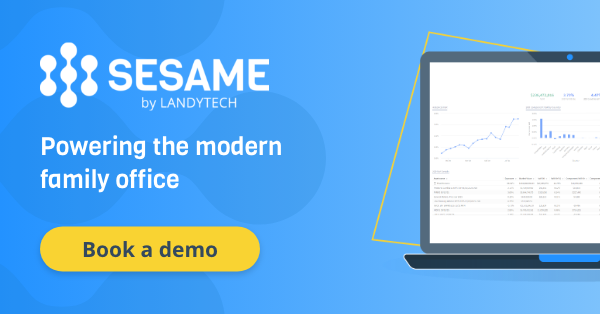Written by Landytech
26 Oct 2022In recent years, family office portfolios have benefited from robust economic growth, relative geopolitical stability, persistently low inflation and interest rates, and relatively low volatility. But family offices, just like other financial market participants, now face greater uncertainty and elevated levels of market volatility.
To navigate this uncertain environment, family offices of all sizes will need a sound risk management framework with effective internal controls. Against this backdrop, many family offices are exploring advanced models and systems once considered the preserve of institutional asset managers, acknowledging that with a strong risk management framework they will be much better prepared to withstand market disruptions.
Here’s everything to consider as part of developing a robust risk management framework for your family office.
Risk measurement, monitoring, reporting
Typically, the data family offices receive from their asset managers does not provide the raw data the actionable insights needed to effectively manage the ongoing investment risk of the family office. In addition to this, most family offices do not have the internal capabilities needed to accurately measure, monitor, analyse and create an aggregate view of investment risks across all its managers and accounts.
To monitor these risks for existing investments and provide an aggregate portfolio-wide risk management report that summarises current risks, alongside potential risks under different markets and economic scenarios, family offices need to develop an internal risk management system backed up by the necessary infrastructure.
Risk management infrastructure
To achieve institutional-quality risk management, family offices must first have the infrastructure in place that enables robust risk measurement and management. For family offices to develop sound risk management processes they need:
Data sourcing
Any risk system will be fuelled by vast amounts of data. To optimise the engine’s results, family offices will need to automate all the feeds, source positions and transactions from different providers (custodian banks, portfolio management systems, prime brokers etc.), and consolidate, cleanse, and enrich the data.
A data warehouse
The risk system is only one part of the technology framework. It needs a supporting technology stack able to automatically receive and store the data, interface with the risk system, and create timely, accurate reports. Efficiency, scalability, and reliability are essential. Databases must be built with the right table structures, and correct relationships between the tables. Proper calculation processes are needed to transform the data so it can be fed to the risk engine.
The primary function of a data warehouse is to store portfolio and market data over time and facilitate ongoing tracking of current and past investment risks and returns. A well-developed data warehouse should be able to perform:
- Data aggregation from multiple sources
- Data reconciliation
- Exposure and performance calculations
- Historical data storage
Risk system
The technological complexity and investment required means family offices rarely develop their own risk systems in-house, instead preferring the validated and audited model robustness that industry-recognised third-party risk engines offer. There are a number of systems to choose from, and some may be more appropriate than others depending on the asset classes deployed. However, service providers are now increasingly able to provide access to institutional-grade risk systems as part of their offering, mitigating costs related to both data access and implementation.
Risk analytics
Within the chosen risk system, family offices must employ a range of multi-asset class, multi –currency performance and risk analytics. The most popular when it comes to family office risk management are:
- Advanced performance and attribution analysis
- Stress tests and scenario analysis
- Risk decomposition and VaR calculations
- Pre-trade what-if simulations
- Key liquidity risk measure monitoring capabilities
Risk management governance
A robust risk management framework needs a fully integrated and well-functioning governance structure. Without proper risk processes and governance, a family office will be unable to escalate and decisively act upon risk issues and to manage them successfully through various market cycles. Alongside the implementation of a data warehouse and risk system, risk and governance processes must be an integral part of the family office’s overall approach to risk.
Key risk processes should include a risk evaluation and due diligence process for current and prospective investments. A limits process that captures the family office’s risk tolerance levels should also be implemented, alongside an escalation process for risk limit breaches.
On the governance side, the family office should have a Risk and Investment Committee that periodically reviews the risk profile of the investment portfolio(s)evaluates, and sets overall risk limits.
The future of family office risk management
Market uncertainty and volatility is driving risk management to the top of the agenda for family offices. According to EY's report, over 90% of family offices are now looking to external partners to help with risk management.
Working with an external provider that has the requisite risk and technology skillsets, and can deliver timely, high-quality results that meet the needs of family offices leaving them free to focus on activities where they can add most value, saving considerable time and cost on the process.
Find out how Landytech is helping family offices enhance their risk capabilities.
Related Content

The Top 10 Family Office Trends in 2024
To say the current economic environment is complex would be an understatement. With interest rates high and structural economic headwinds persisting, many economists believe we are in a “rolling recession” — a slow-growth period with industries...

How your family office should be sourcing wealth data
As today’s UHNW become more geographically dispersed and family officesbecome more sophisticated in their investment functions and allocation strategies,portfoliosnowconsist of multiple asset classes, custodians and currencies, and investments...
-1.jpg)
5 ways to improve productivity in your family office
As family offices attempt to modernise, many are facing productivity challenges due to out-of-date, disparate internal systems andheavily manual processes. Naturally, there are inherent risks associated with such inefficiencies, including missed ...




